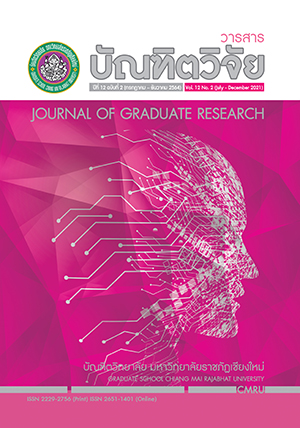การใช้สื่อประกอบการสอนแบบผสมผสานเพื่อพัฒนาทักษะการออกเสียงภาษาอังกฤษของนักเรียนมัธยมศึกษาปีที่ 3
Main Article Content
บทคัดย่อ
การวิจัยครั้งนี้มีวัตถุประสงค์ 1) เพื่อหาประสิทธิภาพของสื่อประกอบการสอนแบบผสมผสานในการพัฒนาทักษะการออกเสียงของนักเรียนชั้นมัธยมศึกษาตอนต้น 2) เพื่อเปรียบเทียบผลสัมฤทธิ์ทางการเรียนด้านการออกเสียงของนักเรียนก่อนและหลังการเรียนโดยใช้สื่อประกอบการสอนแบบผสมผสาน และ 3) เพื่อศึกษาความพึงพอใจของนักเรียนที่มีต่อสื่อประกอบการสอนแบบผสมผสาน กลุ่มเป้าหมายได้แก่นักเรียนชั้นมัธยมศึกษาปีที่ 3 โรงเรียนอรุโณทัยวิทยาคม จำนวน 50 คน โดยการสุ่มแบบเจาะจง ส่วนเครื่องมือในการวิจัยประกอบด้วยสื่อประกอบการสอนแบบผสมผสานที่ใช้เป็นสื่อเสริมในการเรียนการสอน แบบทดสอบความสามารถในการออกเสียงจำนวน 60 คำและแบบสอบถามสำหรับวัดความพึงพอใจของนักเรียนที่มีต่อการใช้สื่อประกอบการสอนในการเรียนแบบผสมผสาน และค่าสถิติในการวิเคราะห์ข้อมูล ได้แก่ค่าเฉลี่ย ส่วนเบี่ยงเบนมาตรฐานและการทดสอบค่าทีที่ไม่เป็นอิสระต่อกัน
ผลการวิจัย พบว่า 1) สื่อประกอบการสอนแบบผสมผสานมีประสิทธิภาพ (E1/E2) เท่ากับ 80.90/80.93 สูงกว่าเกณฑ์ 80/80 2) นักเรียนมีผลสัมฤทธิ์ทางการเรียนด้านการออกเสียงหลังเรียนสูงกว่าก่อนเรียนอย่างมีนัยสำคัญทางสถิติที่ระดับ .01 และ 3) นักเรียนมีความพึงพอใจต่อสื่อประกอบการสอนแบบผสมผสานในระดับสูงมาก (Mean= 4.39, S.D.= 0.76)
Downloads
Article Details

อนุญาตภายใต้เงื่อนไข Creative Commons Attribution-NonCommercial-NoDerivatives 4.0 International License.
เอกสารอ้างอิง
Alsawaier, R. (2018). The effect of gamification on motivation and engagement. International Journal of Information and Learning Technology, 35(1), 56-79.
Anthony, E. (2019). (Blended) learning: How traditional best teaching practices impact blended elementary classrooms. Journal of Online Learning Research, 5(1), 25-48.
Arber, R., Weinmann, M. and Blackmore, J. (2020). Rethinking languages education: Directions, challenges and innovations. Abingdon: Routledge.
Arunsirot, N. (2020). Implementing the augmented reality technology to enhance English pronunciation of Thai EFL students. KKU Research Journal of Humanities and Social Science (Graduate Studies), 8(3), 142-153.
Bates, A. W. (2019). Teaching in a digital age. Vancouver: Tony Bates Associates.
Boelens, R., De Wever, B. & Voet, M. (2017). Four key challenges to the design of blended learning: A systematic literature review. Educational Research Review, 22(1), 1-18.
Burgess, S. and Sievertsen, H. (2020). Schools, skills, and learning: The impact of COVID-19 on education. Retrieved from https://voxeu.org/article/impact-covid-19-education.
Geta, M. and Olango, M. (2016). The impact of blended learning in developing students’ writing skills: Hawassa University in focus. African Educational Research Journal, 4(2), 49-68.
Graham, C. R. (2006). Blended learning systems: Definition, current trends, and future directions. In Bonk, C.J. and Graham, C.R. (Ed.), Handbook of Blended Learning: Global Perspectives, Local Designs (pp. 3-21). San Francisso, CA: Pfeiffer Publishing.
Handoko, H. and Antaridha, R. (2019). The use of blended learning based media in improving student essay writing ability. Jurnal Arbitrer, 6(1), 53-58.
Hernández-Nanclares, N. and Pérez-Rodríguez, M. (2016). Students’ satisfaction with a blended instructional design: The potential of “flipped classroom” in higher education. Journal of Interactive Media in Education, 16(1), 4-20.
Jareonsettasin, T. (2018). Thai educational crisis. Walailak Journal of Learning Innovations, 2(2), 5-23.
Jayalath, J. and Esichaikul, V. (2020). Gamification to enhance motivation and engagement in blended learning for technical and vocational education and training. Retrieved from https://doi.org/10.1007/s10758-020-09466-2
Kaewchum, C. (2018). A study on Thai kindergarten teachers’ perception and production of 10 English problematic final consonant sounds: A case study in the northeast of Thailand. Bangkok: Thammasat University.
Kaur, M. (2013). Blended learning – its challenges and future. Procedia – Social and behavioral sciences, 93(1), 612-617.
Kintu, M., Zhu, C., & Kagambe, E. (2017). Blended learning effectiveness: The relationship between student characteristics, design features and outcomes. International Journal of Educational Technology in Higher Education, 14(7), 212-230.
Kintu, M. J., & Zhu, C. (2016). Student characteristics and learning outcomes in a blended learning environment intervention in a Ugandan University. Electronic Journal of e-Learning, 14(3), 181-195.
Kristanto, A., Mustaji, & Mariono, A. (2017). The development of instructional materials E-learning based on blended learning. International Education Studies, 10(7), 10-17.
Laher, S. and Boshoff, E. (2017). Understanding learner attitudes towards the use of tablets in a blended learning classroom. Perspective in Education, 35(1), 200-213.
Lalima, L. and Dangwal, K. L. (2017). Blended learning: An innovative approach. Universal Journal of Educational Research, 5(1), 1-8.
Lalima, L. and Kiran, L. (2017). Blended learning: An innovative approach. Universal Journal of Educational Research, 5(1), 25-35.
Massner, C. K. (2021). The use of videoconferencing in higher education. IntechOpen, DOI:10.5772/intechopen.99308. Retrieved from https://www.intechopen.com/online-first/77715
McCarthy, J. (2018). Tech integration in blended learning. Retrieved from Tech Integration in Blended Learning | Edutopia.
Nortvig, A., Petersen, A. K., & Balle, S. (2018). A literature review of the factors influencing e-learning and blended learning in relation to learning outcome, student satisfaction and engagement. Electronic Journal of E-learning, 16(1), 46-55.
Puspitarini, Y. D., and Hanif, M. (2019). Using learning media to increase learning motivation in elementary school. Anatolian Journal of Education, 4(2), 53-60.
Ritchie, H., Mathieu, E., Rodés-Guirao, L., Appel, C., Giattino, C., Ortiz-Ospina, E.,..., Roser, M. (2020). Statistics and Research Coronavirus Pandemic (COVID-19). Retrieved from https://ourworldindata.org/coronavirus
Sadiman, A. (2016). Media pendidikam. Jakarta: Raja Grafindo.
Sahatsathatsana, S. (2017). Pronunciation problems of Thai Students learning English phonetics: A case study at Kalasin University. Journal of Education of Mahasarakham University, 11(4), 67-84.
Setyowati, L. (2006). Instructional media in the teaching of English for adult learners. Syntagma, 1(1), 59-67.
Shand, K. and Farrelly, S. G. (2018). The art of blending: benefits and challenges of a blended course for preservice teachers. Journal of Educators online, 15(1), 1-15.
Siraj, K. K., and Maskari, A. A. (2018). Student engagement in blended learning instructional design: an analytical study. Learning and Teaching in Higher Education: Gulf Perspectives, 15(2), 1-19.
The Organisation for Economic Co-operation and Development (OECD) (2020). The impact of COVID-19 on student equity and inclusion: Supporting vulnerable students during school closures and school re-openings. Retrieved from https://www.oecd.org/coronavirus/policy-responses/the-impact-of-covid-19-on-student-equity-and-inclusion-supporting-vulnerable-students-during-school-closures-and-school-re-openings-d593b5c8/
Turmudi, D. (2020). English scholarly publishing activities in the industrial revolution 4.0: What, why, and how? English Language Teaching Educational Journal, 3(1) 52-63.
Ulla, M. (2019). Western-published ELT textbooks: teacher perceptions and use in Thai classrooms. The Journal of Asia TEFL, 16(3), 970-977.
Valieiev, R., Pokaichuk, Y., Zhbanchyk, A., Polyvaniuk, V., Nykyforova, O., & Nedria, K. (2021). In the search for the golden mean: Students` satisfaction with face-to-face, blended and distance learning. Revista Romaneasca Pentru Educatie Multidimensionala, 13(1), 20-40.
Wongsuriya, P. (2020). Improving the Thai students’ ability in English pronunciation through mobile application. Educational Research and Reviews, 15(4), 175-185.


